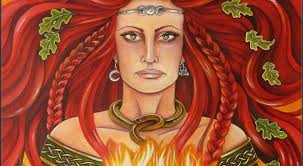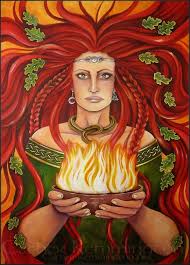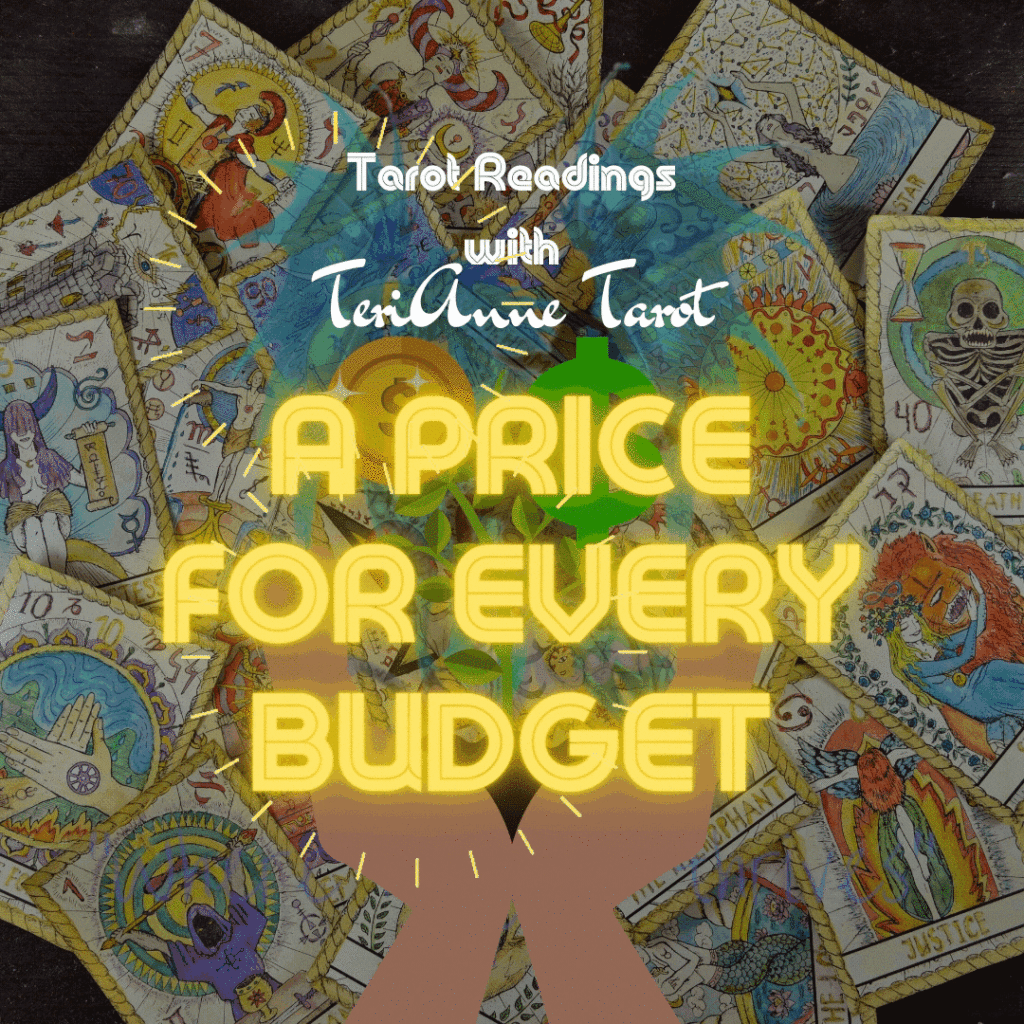What is Imbolc? Imbolc marks the beginning of the lambing season, the stirrings of new life, and signals the start...
What is Imbolc?
Imbolc marks the beginning of the lambing season, the stirrings of new life, and signals the start of Spring. It is Feile Brighde, the ‘quickening of the year’. As a cross quarter day, in the Northern Hemisphere this year (2025) it’s celebrated from sundown February 3rd to sundown on February 4th.
Imbolc, also called Oimealg by the Druids, is derived from the Gaelic word “oimelc”, which means ‘ewes milk’. All is pregnant and expectant. It’s a reminder that winter’s almost over, and spring will be here before we know it — the promise of renewal, of earth awakening and life-force stirring. It is the time of Blessing the seeds and consecrating the agricultural tools. It marks the center point of the dark half of the year. It’s the festival of the Maiden, for from this day to March 21st it’s her season to prepare for growth and renewal. Brigid’s snake emerges from the womb of the Earth Mother to attest the weather (the origin of Ground Hog’s Day), and in many places the first Crocus flowers began to spring forth from the frozen earth.
Traditions
There’s several ways to celebrate this sabbat, and focusing on Brigid is one of my faves.
Brigid (Brighid/Brigit) is the daughter of Dagda. Her two sisters were also called Brigid, and were associated with healing and crafts. The three Brigids were typically treated as three aspects of a single deity, making her a classic Celtic triple goddess. Brigid is a Celtic Goddess of fire, metalcraft, and poetry. She’s called upon for inspiration, divination, creativity, healing, and manifesting.
The Maiden is honored as the Bride on this sabbat. Straw Brideo’gas (corn dollies) are created from oat or wheat straw and placed in baskets with white flower bedding. Young girls then carry them from door to door, and gifts are bestowed upon the image from each household. Afterwards, at the traditional feast, the elder women make special acorn wands for the dollies to hold and in the morning the ashes in the hearth are examined to see if the magick wands left marks as a good omen. Brigid’s Crosses are fashioned from wheat stalks and exchanged as symbols of protection and prosperity in the coming year. Home hearth fires are put out and re-lit, and a besom is placed by the front door to symbolize sweeping out the old and welcoming the new. Candles are lit and placed in each room of the house to honor the rebirth of the Sun.
In some areas, this is the first day of ploughing in preparation of planting the crops. A decorated plough is dragged from door to door, with costumed children following asking for food, drinks, or money. Should they be refused, the household is paid back by having its front garden ploughed up.
In other areas, the plough is decorated and then whiskey, the ‘water of life’, is poured over it. Pieces of cheese and bread are left by the plough and in the newly turned furrows as offerings to the nature spirits. It’s considered taboo to cut or pick plants during this time.
Imbolc Correspondences
Deities
- Brigid (Brighid)
- Aradia
- Athena
- Inanna
- Gaia
- Februa
- Aengus
- Og
- Eros
- Februus
Colors

Plants/Herbs
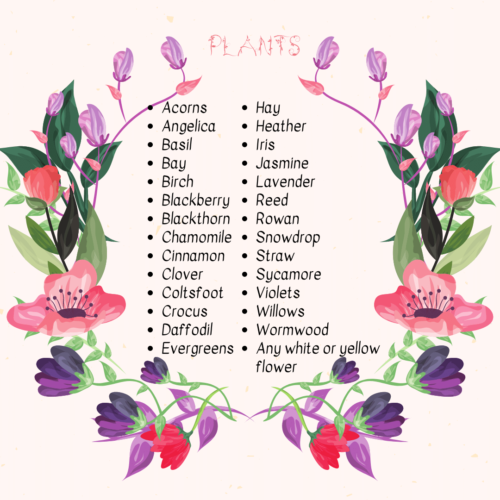
Foods
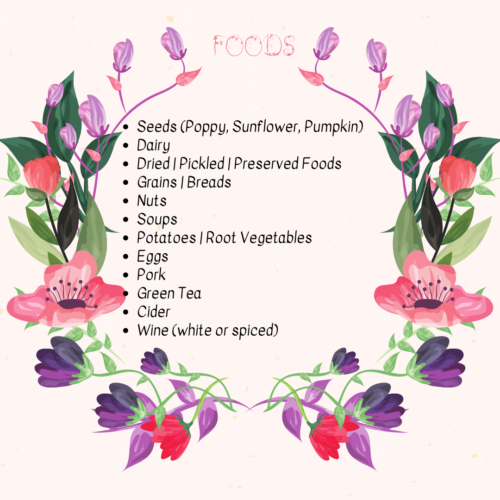
Incense/Oils

Crystals/Stones
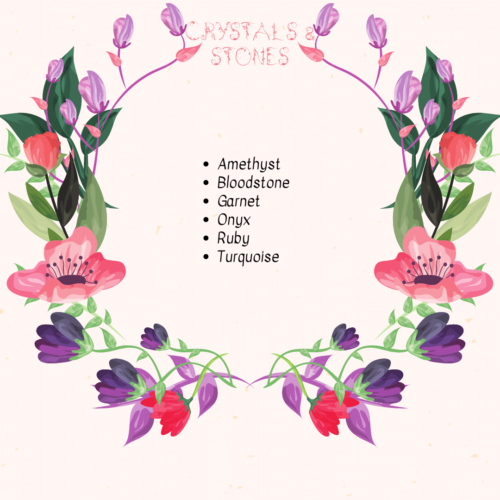
Altar Decor & Symbols
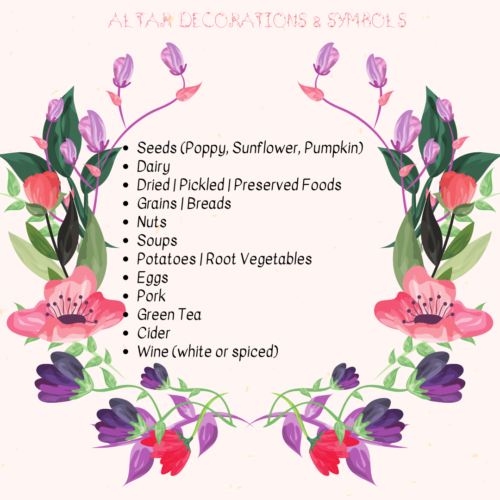
More symbols:
- Besoms
- Brideo’gas
- Crosses
- Candle Wheel
- Ploughs
- Priapic Wands
Animals

Recipes
I found this recipe for an Imbolc Bath Ritual on Instagram. You can access a lot of interesting info from @witchytips.
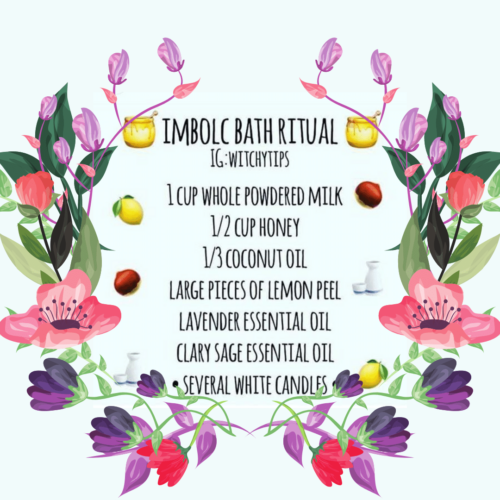
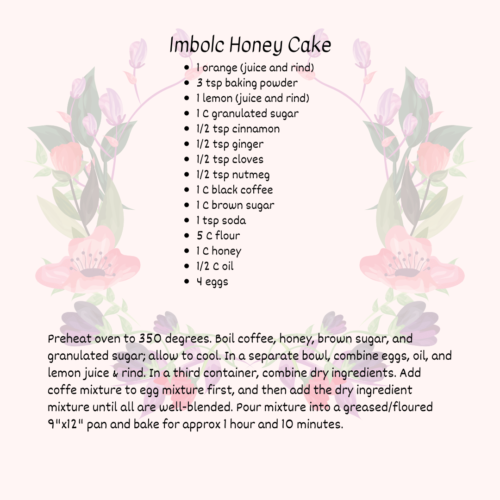
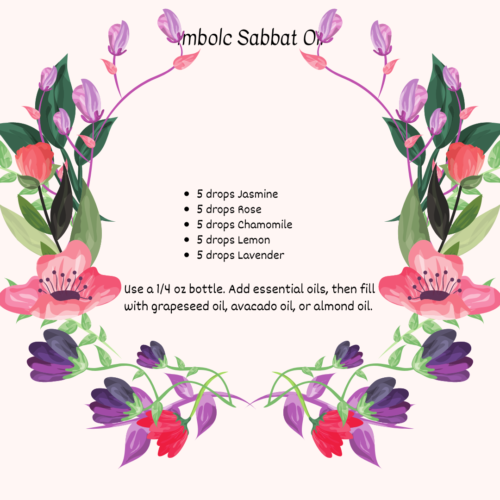
Spellwork


Activities/Crafts
In many Pagan traditions, Brigid is celebrated with crafts that honor her role as the protector of the hearth. You can make a Brigid’s corn dolly, as well as a Bride’s Bed for her to sleep in.
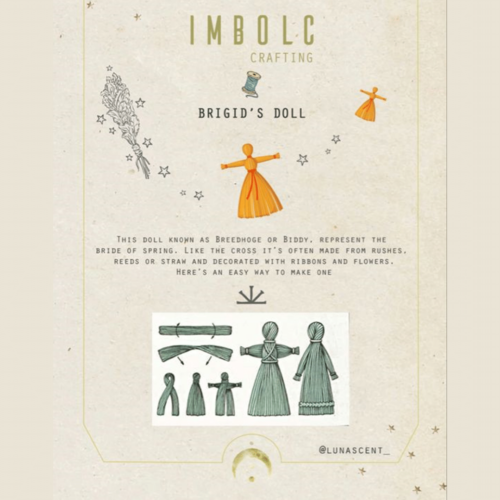
Or you can make one of the best known decorations for Imbolc, a Brigid’s Cross. The arms represent the place where a crossroads comes together; the space between light and dark.

You can even make a Brigid’s Cross out of paper, as shown below.


And in case that’s not enough, here are some prayers & blessings I found on ThoughtCo that are perfect for honoring Brigid, and seasonal blessings for your home.
Blessings
Brigid’s Fire Meal Blessing
The goddess Brigid is well known as a keeper of the hearth fires in the home. As such, she is often associated with matters of domesticity, including cooking and kitchen magic. If you’re prepped a meal and you’re getting ready to dig in, take a moment to bless your food in Brigid’s name.
Brigid is the lady of flame,
the fire that cooks our food!
Hail to her and to the hearth,
and may our meal be good!
Thanks to Brigid Meal Blessing
In some modern Pagan traditions, it is customary to offer a blessing before a meal, particularly if it’s being held in a ritual context. At Imbolc, it’s a season to honor Brigid, the goddess of hearth, home and domesticity. Celebrate her role as a goddess of the home fires, and offer this simple blessing of gratitude before your Imbolc feast.
This is the season of Brigid,
She who protects our hearth and home.
We honor her and thank her,
for keeping us warm as we eat this meal.
Great Lady, bless us and this food,
and protect us in your name.
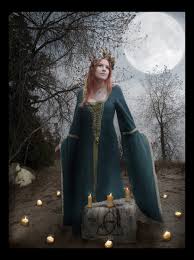
Prayer to Brigid, Bride of Earth
In many modern Pagan traditions, the Imbolc Sabbat is a time to celebrate Brigid, the Celtic hearth goddess. Among her many other aspects, she is known as the Bride of Earth, and is the patroness of domesticity and home. This simple prayer honors her in that role.
Bride of the earth,
sister of the faeries,
daughter of the Tuatha de Danaan,
keeper of the eternal flame.
In autumn, the nights began to lengthen,
and the days grew shorter,
as the earth went to sleep.
Now, Brigid stokes her fire,
burning flames in the hearth,
bringing light back to us once more.
Winter is brief, but life is forever.
Brigid makes it so.
Smooring the Fire – A Prayer to Brigid
Alexander Carmichael was a folklorist and author who spent nearly five decades traveling around the highlands of Scotland collecting stories, prayers and songs. His most noteworthy work, the Carmina Gadelica, is an interesting blend of early Pagan tradition mixed with the influences of Christianity. Smooring the Fire is from Carmichael’s Carmina Gadelica, published 1900, and is a Gaelic hymn to Brigid, honoring the tradition of smooring, or dampening, the hearth fire at night, and particularly on the night before Imbolc.
An Tri numh (The sacred Three)
A chumhnadh, (To save,)
A chomhnadh, (To shield,)
A chomraig (To surround)
An tula, (the hearth)
An taighe, (The house,)
An teaghlaich, (The household,)
An oidhche, (This eve,)
An nochd, (This night,)
O! an oidhche, (Oh! this eve,)
An nochd, (This night,)
Agus gach oidhche, (And every night,)
Gach aon oidhche. (Each single night.)
Amen.
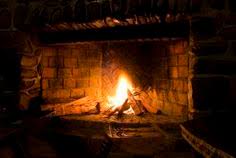
End of Winter Meal Blessing
Although Imbolc isn’t truly the end of winter–and depending on where you live, you might be right smack in the middle of the worst weather of the season–in many traditions, it is a time to look forward towards the spring. It’s a good time to honor the idea that the days are starting to grow a little bit longer and that soon, the harsh cold winter will be coming to an end. Feel free to hold off on this prayer until it’s a little more seasonally appropriate for your area.
The winter is coming to an end
The stores of food are dwindling,
And yet we eat, and stay warm
In the chilled winter months.
We are grateful for our good fortune,
And for the food before us.
Prayer to Brigantia, Keeper of the Forge
The goddess Brigid was known by many names. In parts of northern Britain, she was called Brigantia, and was seen as a keeper of the forge. In this aspect, she is associated with smithcraft and cauldrons. She was connected to the Roman goddess Victoria, a deity who was the personification of victory in battle, as well as loyalty. In some legends she is invoked as Minerva, the warrior goddess. Although as Brigantia she is not nearly as famous as her Brigid aspect, she is seen as the goddess who bestowed the title of Brigantes upon a pan-Celtic tribe in England’s border region.
Hail, Brigantia! Keeper of the forge,
she who shapes the world itself with fire,
she who ignites the spark of passion in the poets,
she who leads the clans with a warrior’s cry,
she who is the bride of the islands,
and who leads the fight of freedom.
Hail, Brigantia! Defender of kin and hearth,
she who inspires the bards to sing,
she who drives the smith to raise his hammer,
she who is a fire sweeping across the land.
Prayer to Brigid, Keeper of the Flame
Among her many other aspects, Brigid is the keeper of the flame, and this simple prayer honors her in that role.
Mighty Brigid, keeper of the flame,
blazing in the darkness of winter.
O goddess, we honor you, bringer of light,
healer, exalted one.
Bless us now, hearth mother,
that we may be as fruitful as the soil itself,
and our lives abundant and fertile.
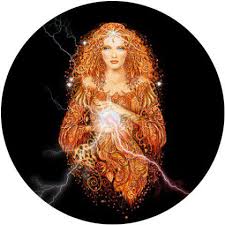
(all images are stock photos)
Be magickal, y’all!

